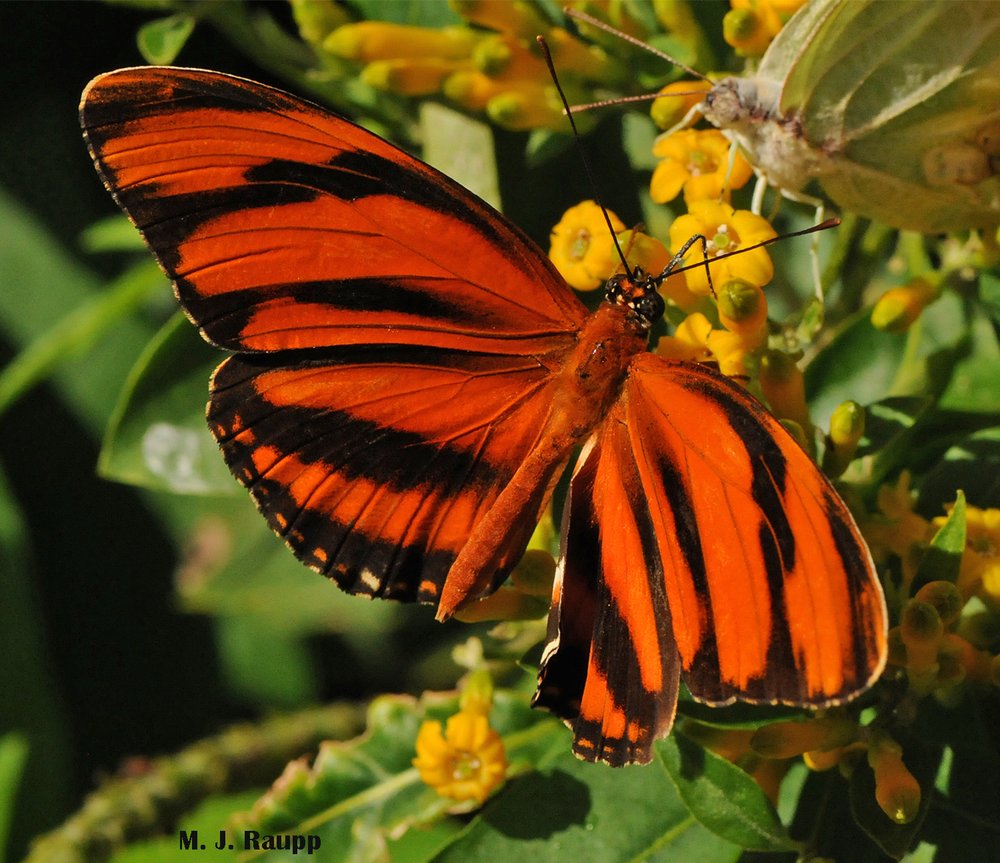From the Bug of the Week Mailbag: Non-native mantids, the European mantis, Mantis religiosa, and Chinese mantis, Tenodera sinensis, enjoying North American cuisine

A small black spot often with a white center, on the inside of each front leg, provides a quick clue used to separate the European mantis from other species found in our region. Image credit: Bjorn Larson
While digging through the Bug of the Week mailbag last week, I ran across an interesting photograph sent from Portland, Oregon a few weeks before Christmas. The critter in question was clearly a praying mantis taking a stroll across a driveway. The question, of course, dealt with the identity of this handsome rascal. Fortunately, the image revealed the mantis in full stride with forelegs extended, thereby revealing the characteristic black and white bullseye on the inside of the foreleg near the joint of leg and body. This marking is diagnostic for the imported European praying mantis, Mantis religiosa.

European mantises vary in color with shades of green, brown, and sometimes bluish-green like this very pregnant beauty collected in Massachusetts.
First discovered in the US in 1899 in New York State, Mantis religiosa may have arrived as a stowaway on a shipment of nursery stock from Europe. In addition to its invaded range in North America, Mantis religiosa resides in parts of Europe, Asia, and Africa. On the east coast, some hoped that this remarkable predator might take a toll on dastardly gypsy moths which arrived in New England in the 1860’s. Unfortunately, this proved not to be the case as large hairy gypsy moth caterpillars were not on the menu for this European gourmand. However, hundreds of European mantises were imported and released in British Columbia during 1937 and 1938 to help curb grasshoppers that regularly decimated agricultural crops. In addition to expanding its range in the eastern US and parts of British Columbia, it can be found in Washington, Oregon, and California.
Mantis religiosa is not the only non-native mantis to join a cadre of more than a dozen members of the mantis family in North America. Perhaps the most well-known non-native mantis here in the US is the Chinese praying mantis, Tenodera sinensis. To learn more about this one, we travel back in time more than a century to October 16, 1897 when Mr. Joseph Hindermyer discovered a large insect “resting on the upper part of his tomato vines” in Mt. Airy, a suburb of Philadelphia. Fortunately, Hindermyer’s neighbor, Philip Laurent, was a member of The Academy of Natural Sciences in Philadelphia and Philip recognized this extraordinary mantis to be different from others found in the area. He later discovered it was an exotic species known from China and Japan. How it arrived in Mt. Airy remains forever shrouded in mystery, but Laurent noted that a large nursery, Meehan and Sons, in nearby Germantown had procured many plants from China and Japan. Could it be that this marvelous predator arrived as a stowaway, perhaps as an embryo in an egg case on a Japanese maple?

This brown egg case, or ootheca, deposited by the lovely blue-green European mantis featured above contains scores of eggs that will survive the winter and hatch next spring.
Fast forward a century to the mid-1990’s. The brown marmorated stink bug arrives in the US less than 60 miles from Mt. Airy in Allentown, PA. In the mid-Atlantic, we all remember what home invasions by stink bugs were like in the decade that followed. The dramatic decline of stink bugs in many eastern states over the last several years is in part related to the fact that several of our indigenous predators, parasitoids, and pathogens are now using brown marmorated stink bugs as a source of food. Prompted by this notion, I decided that it was time to have a reunion between these two historical acquaintances from the east – the Chinese praying mantis and the Asian brown marmorated stink bug. Like many reunions, meeting old acquaintances can be fraught with joy and despair. In the case of the Chinese mantis, the reunion with the Brown Marmorated Stink Bug was gastronomic joy. She consumed a dozen stink bugs in quick succession before nibbling only half of unlucky stink bug number thirteen. As for the stink bugs, well, let’s just say their reunion was filled with short-lived despair. You see, the hungry Chinese mantis mercifully devoured the stink bug’s head first. The reunion between the Chinese mantis and the Asian stink bug evoke Hannibal Lecter’s famous quote, “I do wish we could chat longer, but I’m having an old friend for dinner.”
The reunion between two old acquaintances from Asia, the Chinese mantis and the brown marmorated stink bug, was a happy one for the mantis but not so much for the stink bug. My favorite part of this video appears at the end as the fastidious mantis tidies up after her meal. And yes, this is several times life speed.
Stink bugs are not the only Asian delicacy on the menu for our non-native mantises. A recent report from Penn State revealed praying mantises to be among the top predators of the newest landscape invader, the nefarious Spotted lanternfly. In light of the unending influx of invasive pests to the US, we are fortunate that some of our exotic predators will welcome the arrival of their historical dinner guests.
Acknowledgements
Bug of the Week thanks Bjorn Larson for spotting the European mantis and providing the inspiration for this episode. The fascinating articles “Recent range expansion of the Praying Mantis, Mantis religiosa Linnaeus (Mantodea: Mantidae), in British Columbia” by Robert Cannings, and “Chickens, praying mantises appear to be top predators on spotted lanternfly, study says” by Marcus Schneck provided keen insights for this story.
This post appeared first on Bug of the Week

































